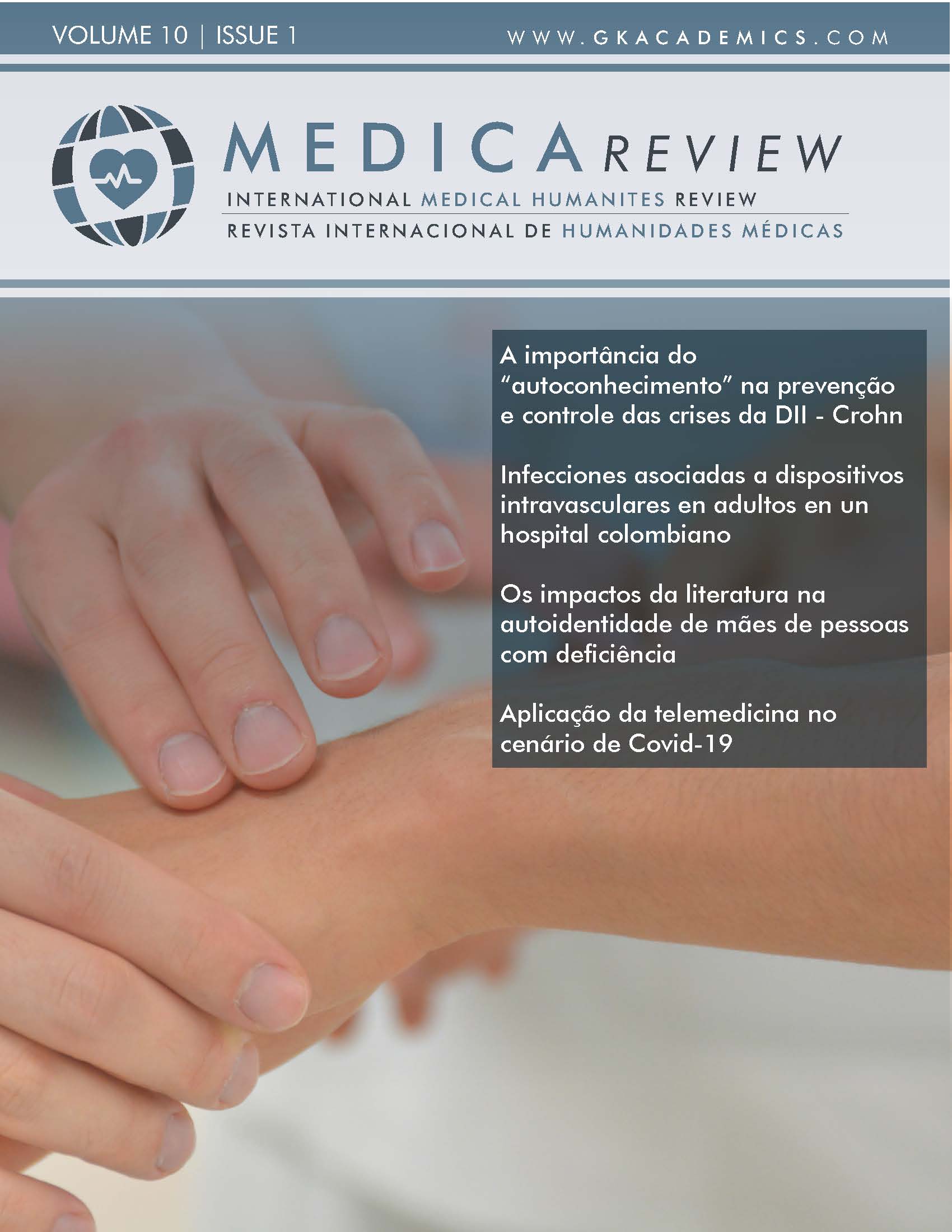Parálisis del Nervio Oculomotor en paciente con Púrpura Trombocitopénica y Síndrome Antifosfolípido
DOI:
https://doi.org/10.37467/gkarevmedica.v10.3120Palavras-chave:
Cefalea, Síndrome antifosfolípido, Parálisis del nervio oculomotor, Púrpura trombocitopénica idiopáticaResumo
Se describe el caso de un paciente con púrpura trombocitopénica idiopática refractario al tratamiento, quien ingresó por cefalea, exotropía del ojo derecho, ptosis palpebral, trombocitopenia severa, requiriendo transfusión. Se realizó resonancia cerebral contrastada que evidenció hemorragia subaracnoidea en el opérculo frontal derecho, con perfil infeccioso, carencial, de autoinmunidad y vasculítico negativos, con perfil para síndrome antifosfolípido positivo. Se consideró posible mecanismo fisiopatológico, trombosis de la vasa nervorum, lo que favoreció la parálisis incompleta del tercer par craneal. Se inició anticoagulación con warfarina, se ajustó terapia inmunomoduladora de enfermedad de base, con evolución favorable del paciente.
Referências
Agostinis, C. B., Bek, A., Bulla, R., Grossi, C., Borghi, M., Meroni, P., & Tedesco, F. (2011). In Vivo Distribution of β2 Glycoprotein I under Various Pathophysiologic Conditions. Blood, 118(15), 4231–4238. doi:10.1182/blood-2011-01-333617
Ali NAM, Tajunisah, I., Subrayan, V., Reddy, S.C., & Goh, KJ. (2008). Antiphospholipid Syndrome Manifesting as Papilledema. Int J Ophthalmol, 1, 277–280.
Álvarez, J., Ardila, M., Urrego, T. y Jaramillo, D. (2021). Síndrome antifosfolípido no trombótico: manifestaciones. Iatreia, 34(4), 347-55. doi:10.17533/udea.iatreia.108
Andreoli, L., Chighizola, C., Banzato, A., Pons, G., Ramire, G. y Erkan, D. (2013). Frecuencia estimada de anticuerpos antifosfolípidos en pacientes con morbilidad del embarazo, accidente cerebrovascular, infarto de miocardio y trombosis venosa profunda: una revisión crítica de la literatura. Artritis Care Res, 65, 1869-73. doi:10.1002 / acr.22066
Arachchillage, D., Efthymiou, M., Mackie, I., Lawrie, A., Machin, S., & Cohen, H. (2014). Anti-protein C Antibodies are Associated with Resistance to Endogenous Protein C Activation and a Severe Thrombotic Phenotype in Antiphospholipid Syndrome. Journal of Thrombosis and Haemostasis : JTH, 12(11), 1801–1809. doi:10.1111/jth.12722
Bancsi, L., van der Linden, I., & Bertina, R. (1992). Beta 2-glycoprotein I Deficiency and the Risk of Thrombosis. Thrombosis and Haemostasis, 67(6), 649–653.
Breen, K., Seed, P., Parmar, K., Moore, G., Stuart-Smith, S., & Hunt, B. (2012). Complement Activation in Patients with Isolated Antiphospholipid Antibodies or Primary Antiphospholipid Syndrome. Thrombosis and Haemostasis, 107(3), 423–429. doi:10.1160/TH11-08-0554
Calvo, I. (2002). Síndrome antifosfolípido. Reumatología, 85-94. https://www.aeped.es/sites/default/files/documentos/14-antifosfolipido.pdf
Cervera, R. (2010). Estrategias terapéuticas en el síndrome antifosfolipídico. Reumatología Clínica, 6(1), 37–42. doi:10.1016/j.reuma.2008.11.020
Cervera, R., & Espinosa, G. (2018). Antiphospholipid Syndrome. Medicina Interna, 25(4), 303-308. https://doi.org/10.24950/rspmi/revisao/4/2018
Cervera, R., Serrano, R., Pons, G., Ceberio, L., Shoenfeld, Y., & de Ramón, E. (2015). Morbidity and Mortality in the Antiphospholipid Syndrome during a 10-year Period: a Multicentre Prospective Study of 1000 Patients. Annals of the Rheumatic Diseases, 74(6), 1011–1018. doi:10.1136/annrheumdis-2013-204838
Champion, BL., Choy, F., Schrieber, L., Roche, J., & Rowe, DB. (2002). Isolated Fascicular Oculomotor Nerve Palsy as the Initial Presentation of the Antiphospholipid Syndrome. J Clin Neurosci, 9, 691–694.
Dey, M., Charles Bates, A., & McMillan, P. (2013). Superior Ophthalmic Vein Thrombosis as an Initial Manifestation of Antiphospholipid Syndrome. Orbit, 32, 42–44.
Espinosa, G., & Cervera, R. (2008). Antiphospholipid Syndrome. Arthritis Research and Therapy, 230.
Forastiero, R. y Martinuzzo, M. (2006). Acción de los anticuerpos antifosfolípidos sobre los mecanismos inhibitorios del factor X activado. Posible mecanismo fisiopatológico del síndrome antifosfolípido. Acta Bioquímica Clínica Latinoamericana, 307-315. https://www.redalyc.org/articulo.oa?id=53540305
Franco, A., Medina, F., Balbi, G., Levy, R. A., & Signorelli, F. (2020). Ophthalmologic Manifestations in Primary Antiphospholipid Syndrome Patients: A Cross-sectional Analysis of a Primary Antiphospholipid Syndrome Cohort (APS-Rio) and Systematic Review of the Literature. Lupus, 29(12), 1528–1543. https://doi.org/10.1177/0961203320949667
Garcia, D., & Erkan, D. (2018). Diagnosis and Management of the Antiphospholipid Syndrome. The New England journal of medicine, 378(21), 2010–2021. doi:10.1056/NEJMra1705454
Giorgi, D., Gabrieli, CB., & Bonomo, L. (1998). The Clinico-ophthalmological Spectrum of Antiphospholipid Syndrome. Ocul Immunol Inflamm, 6, 269-273.
Girón, J. A., García del Río, E., Rodríguez, C., Rodríguez, J., & Serrano, A. (2004). Antiphospholipid Syndrome and Asymptomatic Carriers of Antiphospholipid Antibody: Prospective Analysis of 404 Individuals. The Journal of Rheumatology, 31(8), 1560–1567.
Gropp, K., Weber, N., Reuter, M., Micklisch, S., Kopka, I., Hallström, T., & Skerka, C. (2011). β₂-glycoprotein I, the Major Target in Antiphospholipid Syndrome, is a Special Human Complement Regulator. Blood, 118(10), 2774–2783. doi:10.1182/blood-2011-02-339564
Hoppensteadt, D., Fabbrini, N., Bick, R., Messmore, H., Adiguzel, C., & Fareed, J. (2008). Laboratory Evaluation of the Antiphospholipid Syndrome. Hematology/Oncology Clinics of North America, 22(1), 19. doi:10.1016/j.hoc.2007.10.009
Ibáñez, S., Iruretagoyena, M. y Gutiérrez, M. (2013). Nuevas estrategias en el tratamiento del síndrome antifosfolípido. Revista médica de Chile, 141(8), 1041-1048. doi:10.4067/S0034-98872013000800011
Leal, D., Zubiaurre, V., Danza, A. y Stevenazzi, M. (2021). Síndrome antifosfolipídico obstétrico. Revista Uruguaya de Medicina Interna, 6(2), 36-46. doi:10.26445/06.02.5
Liestøl, S., Sandset, P., Jacobsen, E., Mowinckel, M., & Wisløff, F. (2007). Decreased Anticoagulant Response to Tissue Factor Pathway Inhibitor Type 1 in Plasmas from Patients with Lupus Anticoagulants. British Journal of Haematology, 136(1), 131–137. doi:10.1111/j.1365-2141.2006.06385.x
Lirola, M. y Camacho, M. (2020). Síndrome antifosfolípido. Protoc diagn ter pediatr, 2, 141-154. https://www.aeped.es/sites/default/files/documentos/12_sind_antifosfolipido.pdf
Macías, J., Barco, N. y Barreda, F. (2012). Trombofilia y síndrome antifosfolipídico: a propósito de un caso. Revista Médico-Científica "Luz y Vida", 3(1), 56-60. https://www.redalyc.org/pdf/3250/325028226012.pdf
Miyakis, S., Lockshin, M., Atsumi, T., Branch, D., Brey, R., Cervera, R., & Krilis, S. A. (2006). International Consensus Statement on an Update of the Classification Criteria for Definite Antiphospholipid Syndrome (APS). Journal of Thrombosis and Haemostasis : JTH, 4(4), 295–306. doi:10.1111/j.1538-7836.2006.01753.x
Núñez, C. y Cabiedes, J. (2011). Mecanismos patogénicos de los anticuerpos antifosfolípidos. Reumatol Clin, 7(1), 72–76. doi:10.1016/j.reuma.2009.10.005
Oku, K., Amengual, O., Hisada, R. O., Nakagawa, I., Watanabe, T., Bohgaki, T., & Atsumi, T. (2016). Autoantibodies against a Complement Component 1 q Subcomponent Contribute to Complement Activation and Recurrent Thrombosis/Pregnancy Morbidity in Anti-phospholipid Syndrome. Rheumatology (Oxford, England), 55(8), 1403–1411. doi:10.1093/rheumatology/kew196
Pengo, V., Testa, S., Martinelli, I., Ghirarduzzi, A., Legnani, C., Gresele, P., & Ruffatti, A. (2015). Incidence of a First Thromboembolic Event in Carriers of Isolated Lupus Anticoagulant. Thrombosis Research, 135(1), 46–49. doi:10.1016/j.thromres.2014.10.013
Petri, M. (2000). Epidemiology of the Antiphospholipid Antibody Syndrome. Journal of Autoimmunity, 15(2), 145-151. doi:10.1006/jaut.2000.0409
Pras, E., Neumann, R., Zandman-Goddard, G., Levy, Y., Assia, E. I., Shoenfeld, Y., & Langevitz, P. (2004). Intraocular Inflammation in Autoimmune Diseases. Semin Arthritis Rheum, 34(3), 602–9.
Ricarte, I., Dutra, L., Abrantes, F., Toso, F., Barsottini, O., Silva, G., & Andrade, D. (2018). Neurologic Manifestations of Antiphospholipid Syndrome. Lupus, 27(9), 1404–1414. doi:10.1177/0961203318776110
Ruiz, O., Guerrero, M., Montenegro, C., Díaz, D., Delgado, C. y Marangoni, M. (2011). Prevalencia de anticuerpos antifosfolípidos en pacientes con conectivopatías. Anales de la Facultad de Medicina, 72(3), 187-190. http://www.scielo.org.pe/scielo.php?script=sci_arttext&pid=S1025-55832011000300006&lng=es&tlng=es
Sanna G, D.C.¸ Ruz, D., & Cuadrado, M.J. (2006). Cerebral Manifestations in the Antiphospholipid (Hughes) Syndrome. Rheum Dis Clin North Am, 32, 465–90
Shin, S.Y., & Lee, J.M. (2006). A case of Multiple Cranial Nerve Palsies as the Initial Ophthalmic Presentation of Antiphospholipid Syndrome. Korean J Ophthalmol, 20, 76e8.
Suvajac, G., Stojanovich, L., & Milenkovich, S. (2007). Ocular Manifestations in Antiphospholipid Syndrome. Autoimmun Rev, 6, 409–14.
Tamhankar, M. A., Biousse, V., Ying, G. S., Prasad, S., Subramanian, P. S., Lee, M. S., Eggenberger, E., Moss, H. E., Pineles, S., Bennett, J., Osborne, B., Volpe, N. J., Liu, G. T., Bruce, B. B., Newman, N. J., Galetta, S. L., & Balcer, L. J. (2013). Isolated Third, Fourth, and Sixth Cranial Nerve Palsies from Presumed Microvascular Versus Other Causes: a Prospective Study. Ophthalmology, 120(11), 2264–2269. https://doi.org/10.1016/j.ophtha.2013.04.009
Tektonidou, M., Andreoli, L., Limper, M., Amoura, Z., Cervera, R., Costedoat, N., & MM., W. (2019). Recomendaciones EULAR para el manejo del síndrome antifosfolípido en adultos. Anales de las enfermedades reumáticas, 78, 296-1304.
Utz, V. M., & Tang, J. (2011). Ocular Manifestations of the Antiphospholipid Syndrome. The British journal of ophthalmology, 95(4), 454–459. https://doi.org/10.1136/bjo.2010.182857
Downloads
Publicado
Como Citar
Edição
Seção
Licença
Os autores/as que publicam nesta revista concordam com os seguintes termos:
- Os autores/as terão os direitos morais do trabalho e cederão para a revista os direitos comerciais.
- Um ano após a sua publicação, a versão do editor estará em acesso aberto no site da editora, mas a revista manterá o copyright da obra.
- No caso dos autores desejarem asignar uma licença aberta Creative Commons (CC), poderão a solicitar escrevendo a publishing@eagora.org.









